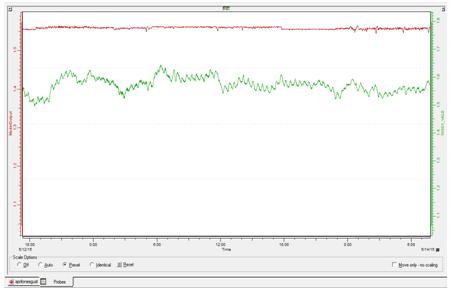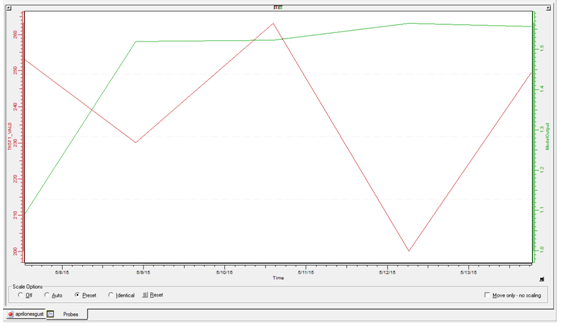ПРОБЛЕМА СТАБИЛИЗАЦИИ ПРОЦЕССА СГУЩЕНИЯ И ВОЗМОЖНЫЙ МЕТОД ЕЕ РЕШЕНИЯ
Николаев А.Н.1, Шариков Ю.В.2
1аспирант 3–го года обучения, 2Профессор, доктор технических наук, доцент, Национальный минерально-сырьевой университет «Горный»
ПРОБЛЕМА СТАБИЛИЗАЦИИ ПРОЦЕССА СГУЩЕНИЯ И ВОЗМОЖНЫЙ МЕТОД ЕЕ РЕШЕНИЯ
Аннотация
В этой статье, были исследованы производственные данные (Талнахская обогатительная фабрика). Был проведен их анализ и выявлены основные факторы, влияющие на конечный продукт. В ходе исследования было оценено соотношение между плотностью сгущения и качества выпускаемой продукции. Были выбраны факторы, влияющие на стабильную работу сгустителя, и создана его статистическая модель.
Ключевые слова: Обогатительная фабрика, сгущение пульп, реагент, выходной концентрат, плотность пульпы, моделирование процесса сгущения.
Nikolaev A.N.1, Sharikov Y.V.2
1postgraduate student, 2Professor, Doctor of Technical Science, National Mineral Resources University (Mining University)
THE PROBLEM OF STABILIZATION OF THE THICKENING PROCESS AND POSSIBLE METHOD TO SOLVE IT
Abstract
In this paper, the production data were investigated (Talnahskaya mineral – processing plant). It was carried out their analysis and revealed the main factors, which influence on the final product. Relationship was evaluated between the thickening density and quality of the output product. Factors influencing on the stable thickener work were chosen. Statistical thickener model has been created.
Key words: Mineral – processing plant, pulp thickening, reagent, output concentrate, pulp density, simulation of thickening process.
Introduction
The thickening process is one of the most important and most common processes of metallurgy, ore-dressing treatment, and other many industries. Thickening is a process of increasing the solids concentration in the slurry due to sedimentation of solid particles and simultaneous removal of the purified water layer. The process of thickening pursues the following objectives:
- Obtain thickened product;
- Obtain a clean sink;
- To achieve both objectives.
Thickening is a very complex process with many disturbances and, therefore, its automation and control is a rather difficult and complicated problem.
Quality of output product is directly dependent on the quality of the thickening process, that is why many scientists are now engage in the creation and improvement of control systems and optimizing thickening systems.
For create such system, we need to study thickening process in detail, to explore all the factors, which influence on the course of the process, set all the dependencies. Next, we need to treat the results and to create a corresponding model.
Research
As mentioned above, the thickening process directly affects to the quality of the output concentrate. If this process is not stable, then resulting output product is not stable as well. To stabilize the thickening process is necessary to create an automated system that could bring all the quality thickening indicators to ideal.
For our research, we took the production data from the Talnakh Ore Dressing Plant (Norilsk Nickel). They contained per-minute values of the following variables: the average density of the entire department of condensation; the density of each thickener; power consumption, the level of each thickener; the level of the junction box; pulp density in the junction box; Ni content of the concentrate outlet; supply flotation reagents in the flotation separation. 16,000 values in total. We decided to carry out their treatment in a specialized environment, Proficy Troubleshooter.
Proficy Troubleshooter is software package from the company GE Intelligent Platforms, offers a huge selection of analytical tools. It uses advanced technology to extract knowledge from existing historical operating and production data.
Proficy Troubleshooter can be used for batch processes and for work with continuous processes. This package allows to determine the technological problems and their causes, by modeling of the process based on the existing production data. Proficy Troubleshooter is essentially a Historian server with the presence of intellectual component.
When you identify the causes of deviations and problems in the process, and also the impact of processes on the equipment, it will be easier to understand the relationship between the data. It is also possible to work out production scenario without using real hardware.
The main advantages of this software package are:
- Identification of possible causes and variations in processes
- Implementation of various scenarios
- Automatic determination of production data process laws
- Evaluation of benefits introducing recommendations
Initially it was required to analyze the variables, which influence on output Ni concentrate. With Proficy Troubleshooter found that: the correlation relationship between Ni content and average density of all thickeners ƞ = 86, 63%; correlation relationship between Ni content and thickener loading ƞ = 64, 73%; correlation relationship between Ni content and average flotation reagent ƞ = 65, 43%, where ƞ –correlation coefficient.
As we can see from the above data, the greatest impact on the output product has an average density of pulp withdrawn from the thickening separation.
Also, with using one of the Continuous Troubleshooter function, it was monitored for change in the Ni content value with changing the average density of thickeners.
This feature allows us to track changes in the numerical output value, and helps to determine the optimal value of the pulp density. In order to obtain the optimum concentrate with Ni content equal 9%, this value must be 1.5 kg / l.
From studies above, we can see that to optimize the thickening process, we need to obtain a stable thickening pulp density, in this case this value is 1.5 kg / l.
In our case, in the thickening department there are 4 thickeners and one junction box. Consequently, it is necessary to bring the density of each thickener to a value of 1.5 kg / l. To solve this problem, we needed to identify all value, which influence to the density, and build a model of the thickener with a control loop.
For search dependencies and optimal values, we used data from Talnakh Concentrator. This data is loaded into a software package Proficy Troubleshooter for treatment. In our case, the flocculant dosing is not measured, it is fed by hand and making it difficult for stabilization process. The data loaded into the Proficy Troubleshooter include the following values: output density; loading and unloading of the thickener, the thickener levels, the current supplied to the tine thickener.
After the research, the following results were obtained. It was identified the major value, which influence on the density. Thickener charging in relation to the density has a correlation value h = 83, 25%. Thickener unloading in relation to the density has a correlation value for h = 92, 96%. As we can see, control of thickener for stabilization of density may produce by controlling loading and unloading of the thickener.
The statistical thickener model was created with one of the Proficy Troubleshooter functions. The model has a coefficient of determination equal to 96%. This percentage is high enough to recognize that the model is adequate. When we submitted production data to the input of the model, on output were received values, which have maximum approximation with experience data. In Figure 1, you can see the results of the model work.
Fig. 1 - Real Output density against Model output density [1]
Proficy Troubleshooter allows us to optimize of the received model. With the help of a specialized Non Linear Optimization unit we added several conditions, first of all, we pointed out that it is necessary to minimize the difference between a 1,5 and a output model, and secondly, we choosed variable for control, in our case it is a thickener discharge, because this value has the highest correlation. The obtained results are shown in Figure 2.
Fig. 2 - Control of the output density [2]
Conclusions
After research we can make following conclusions:
- Unstable thickening process leads to huge material losses. This is losses of expensive reagent, not full recovery of product, huge losses in the tails. The system of stabilization is required to solve these problems. With such system we could get the optimum value of extracting useful product.
- Based on studies we was selected parameter which should be stabilized to obtain high-quality output product -this is the average density of the suspension.
- The study with using a software package Proficy Troubleshooter has been conducted and were found values, which affects to the average pulp density, in our case it is loading and unloading thickener.
- The statistical thickener model has been built. This model was considered to obtain possibility to control thickening process by means of loading and unloading.
References
- Kostryukova T. N., Zarubin R. V., Kotenev D. V. Technological instruction of ores enrichment on the Talnahskaya mineral-processing plant . – Talnakh, 2004. – 333 p. (rus)
- Bolotaeva, I. I. Research and development of automated process control system in the thickened pulp industry. – Vladikavkaz, 2006. – 127 p. (rus)
- Tekiev V. M., Podunov V. S., Petrosyants S. A. Development of a mathematical model of a thickening process. – SKGMI, 1974. – 37 p. (rus)
- Kamynin L. I. Course of mathematical analysis. – Moscow: MGU. Tom 1, 2001. – 624 p. (rus)
- Shishkin E. V., Chkhartishvili A. G Mathematical methods and models in the management. – Moscow: Delo, 2000. – 431 p. (rus)


